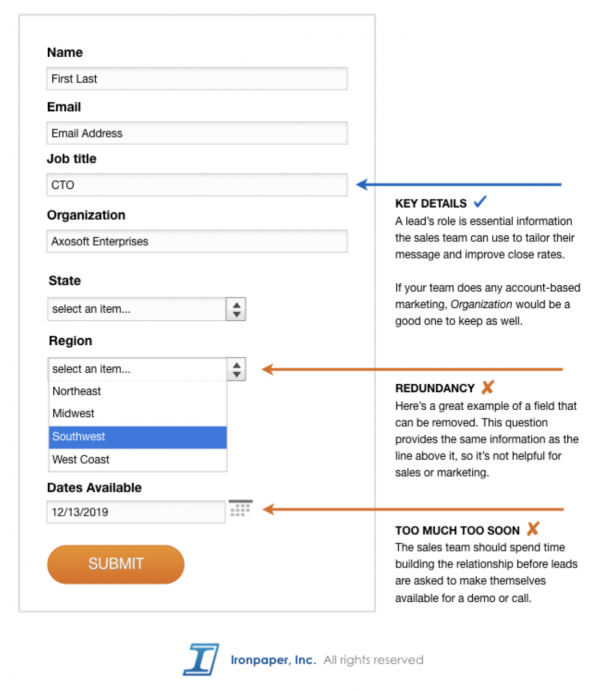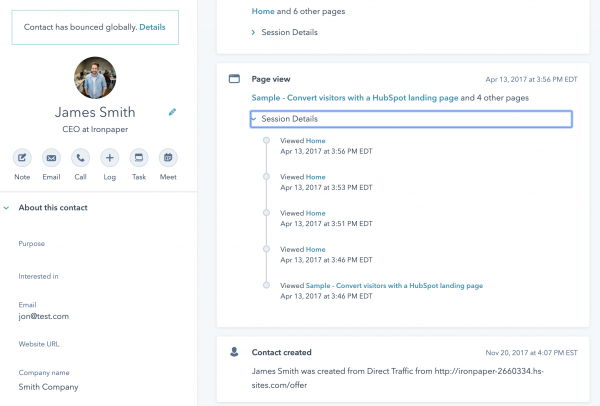

By Arielle Hurst
We hate to break it to you, but there aren’t any universal silver bullets that will instantly improve your conversion rates. Although some marketers may strike gold during an A/B test and announce, "Orange buttons tripled our conversions!"
This dramatic boost is not guaranteed for every B2B company looking to generate more leads. If it were really that simple, every single marketing site would look exactly the same, with the same orange buttons.
Instead, the most successful businesses test, measure and gain insights into their own optimizations. Your audience is unique, and so is your definition of a conversion.
While one company wants to grow its email list with a broad range of potential customers, another is focused on targeting highly-qualified leads with a product trial. Even the definition of a qualified lead is different for each company, so everyone's "conversion" varies, and there are no standard ways to generate these leads.
Even the definition of a qualified lead is different to each company, so everyone's "conversion" varies.
That’s why every business needs different tactics to improve website performance, and only continuous testing, iteration, and refinement will reveal your unique best practices.
One of the most common conversion rate tips is to slash the amount of content and number of form fields on a page. Nobody reads anymore, right?
Depending on your perspective, the statistics are technically true: Stripping away a few fields and paragraphs may increase the number of people who submit the form, but to understand why this can be a bad idea, we need more context.1
 Seems more effective, right?
Seems more effective, right?
Marketing and sales teams are trying to work together on lead generation and management, but if sales doesn’t trust the lead quality, they won’t pursue contacts provided by marketing. Over time, this will diminish the relationship between marketing and sales. The marketing team will have its value constantly questioned, which leads to hostility and poorer results.
When sales needs to tailor their message to each potential customer, it doesn’t make sense to stop gathering crucial information through forms on the website. This practice limits the sales team’s ability to qualify contacts and marketers’ ability to further target and nurture the lead based on relevant information.
While your company may gain hundreds of new contacts using this tactic, many may not be good candidates for your product or service. Some people will fill out a form because there are fewer fields, even if they’re only mildly interested in your business or the content offer.
When you lower the barrier to conversion, you’re inviting the wrong contacts – competitors, independent researchers, lukewarm leads, and more – into your CRM. This is often the first domino that tips MQLs (marketing qualified leads) out of favor with sales teams.
A better way to optimize for the right leads is to provide a more compelling reason to convert. So, instead of arbitrarily reducing form fields, add more value for the website visitor. If the form is on a generic “Contact Us” page, consider replacing it with the opportunity to get an e-book, webinar, or custom demo that pinpoints a problem your audience experiences.
To give this extra impact, add even more context. Show snippets of what they will receive. Research your audience and further fine-tune your value proposition to their needs. Learn to speak their language, and you will generate more, better leads willing to trade qualifying details for your compelling content.
Of course, there may be good reasons to reduce form fields if the information they collect isn’t valuable, but make sure you talk to your sales counterparts, test the changes, and analyze lead quality before you ax everything.
The lesson here isn’t that reducing content can never work; it’s that nothing is a universal fix that should be done arbitrarily. There are better ways to reduce friction on conversion points than lowering the barrier-to-entry.

There is no magic number of fields. It’s about gathering the information that provides real value.
Though there are no hard and fast rules for conversion rate optimization, there are definitely a set of best practices that your company can use to convert your ideal leads into sales. Just remember, one business’ winning strategy is another business’ losing strategy, so you need to put in the work upfront to figure out what these best practices are.
The benefit of taking a research-based approach is that you’ll develop a playbook of data-backed insights that will help you shortcut success on future campaigns.
It’s all about assessing a variety of messages and channels, then analyzing what works with cold, hard data.
So, what does this process look like? It’s all about assessing a variety of messages and channels, then analyzing what works with cold, hard data. You’ll need to ensure you have the right infrastructure to track performance, like a robust CRM, then experiment with different messaging, design, and content.

If you pay attention to the analytics as you run your tests, patterns will emerge.

You’ll soon find out if Google Ads works better than LinkedIn ads, if eBooks convert more quality leads than webinars, and which organic keywords lead to sales. Over time, your conversion rate will improve as you optimize your own best practices.
If you need help defining your value proposition or running tests with analytical insights, talk to a conversion rate optimization agency that can walk you through the process.
1. https://conversionxl.com/blog/reduce-form-fields/
by Jonathan Franchell, CEO of Ironpaper - For more tips and hacks: Need to remove a new line after h1 tags? Both web designers and SEO practitioners need to employ headline tags: H1, H2, H3 in several ways to improve web page structure and tag...

The Crowded Arena of the IT Marketplace Updated December 2024 The Information Technology (IT) landscape is experiencing rapid growth and intensifying competition. IT spending is projected to reach nearly 5.1 trillion U.S. dollars in 2024, a...

Updated December, 2024 The field of digital marketing is evolving rapidly in response to new technology and changing buyer expectations. To help career-minded marketers, we’ve rounded up the top 10 skills needed to succeed in the field. These are...

The marketing industry is transforming significantly due to generative AI and increasing market complexity. Gartner's prediction of a 25% decline in traditional search traffic suggests that the era of search engines is dying. AI tools, particularly...
